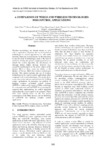A comparison of wired and wireless technologies for control applications
Title
A comparison of wired and wireless technologies for control applicationsAuthor(s)
Date
2018Citation
Calvo, I., Abrahams, S., Barambones, O., Chouza, A., Velasco, J., Sáez de Ocáriz, I., Quesada, J. A comparison of wired and wireless technologies for control applications. En Actas de las XXXIX Jornadas de Automática, Badajoz, 5-7 de Septiembre de 2018 (pp.538-545). DOI capítulo: https://doi.org/10.17979/spudc.9788497497565.0538 DOI libro: https://doi.org/10.17979/spudc.9788497497565
Versions
http://hdl.handle.net/10662/8435
Abstract
[Abstract] Wireless technologies are already mature in noncritical applications. However, the use of this kind of technologies in control applications is, still, under research. There are several reasons for the reluctance
to use this kind of technologies such as the lack of reliability, finding the optimal sampling period not to disturb the control algorithm, the introduction of message delays, higher message dropouts (e.g. caused by interferences) or the power supply at the devices. Most of these issues are related to the Quality of Service (QoS) that wireless technologies provide. This article evaluates the use of wireless technologies to be used in control applications when compared with wired technologies. The article draws some conclusions and recommendations for building control applications. In particular, the problem of building wireless networked control systems (WNCS) is addressed by means of XBee technology for communication and LabVIEW for processing the acquired data, implementing the control algorithm and sending the control signal to the actuators. These tools were selected based on the low power consumption of the XBee devices and the flexibilityof LabVIEW for building complex control applications.
Keywords
Wireless communications
Networked control systems (NCS)
Zigbee
XBee
LabVIEW
Networked control systems (NCS)
Zigbee
XBee
LabVIEW
Editor version
Rights
Atribución-NoComercial 3.0 España
ISBN
978-84-09-04460-3 (UEX) 978-84-9749-756-5 (UDC electrónico)







